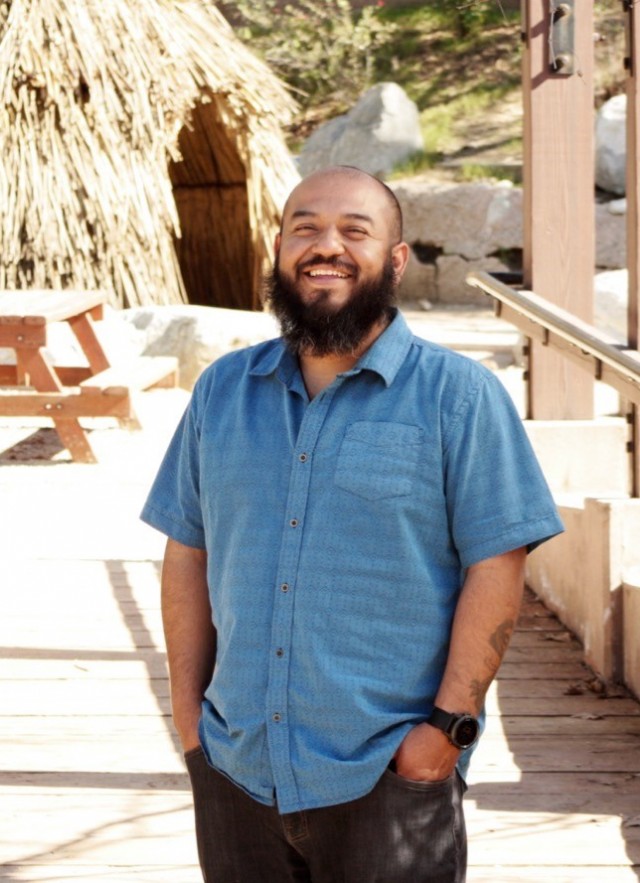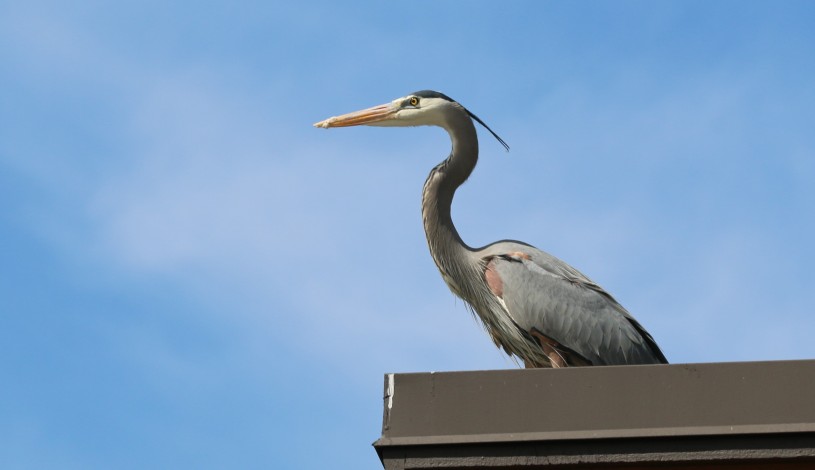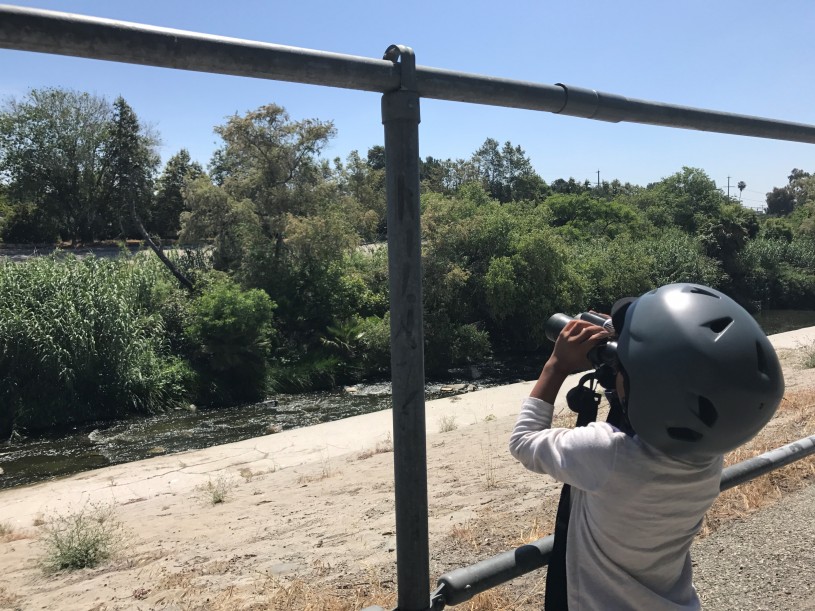Voices of L.A. Nature: An Interview with Marcos Trinidad
Welcome to Voices of L.A. Nature, where we'll hear stories from a diverse range of Angelenos about their relationships with nature in L.A.

Marcos Trinidad has a deep, personal connection to both nature and L.A. He rates himself an 11/10 on the, "I love nature scale!" He hails from a long line of Angelenos; his family has lived in Northeast L.A. for over 70 years. Marcos was born and raised in Highland Park. Today Marcos is further developing his family's relationship with nature in the area, through his work and with his two children Paloma and Bija. Keep reading to find out more about his relationship to, and adventures through the amazing nature of L.A.!
Can you tell us a little bit about your career?
I’m currently the Center Director for the Audubon Center at Debs Park. We are a community nature center in Northeast LA. We work on a variety of conservation issues that affect birds throughout Los Angeles and most importantly, we connect and reconnect our community with nature and the land we live on. Over the past four years, I have nurtured a growing community of volunteers, youth, and community partnerships; implemented a facility and grounds improvement plan; and partnered with the National Park Service to establish a vibrant native plant nursery. Prior to coming to Debs, I served as Director of Audubon Youth Environmental Stewards (a program of the Palos Verdes/South Bay Audubon Society), where I had the privilege to engage and inspire youth. and help them to connect to nature and their community through restoration and volunteer projects. I’ve also spent time as a Biology Technician for the U.S. Forest Service and an Urban Forester for both Northeast Trees and TreePeople. My formal education is in geology and anthropology.

Do you incorporate nature into your daily life?
Yes. I make time to experience nature every day. I enjoy hiking our trails at Debs Park or in my neighborhood parks. In particular, I pay close attention to our feathered friends in the sky, I listen to the songs they sing. I listen because birds tell us a story about our neighborhoods. They tell us about the health of our communities. We just have to listen. Urban nature is such a joy to follow because our lives are overlapping with so many different species that are so magical. If we can appreciate the magic in them, we start to appreciate the magic in ourselves.
Can you share a memory/story of where and how you played as a kid?
As a kid, my friends and I had a tree house located in a Pic ’N’ Save parking lot in Highland Park. The tree was a huge ficus tree (Ficus microcarpa) and had an amazing branching structure. It was wonderful how it provided multiple “kick it” spots all throughout the canopy. This is where we grew up. Where we learned to communicate, where we learned to stand up for ourselves, where we learned the rules of the street. It is where the seed was planted for my lasting relationship with trees and the love for my community. It’s hard to explain the importance of having that space as a teenager. Even though it was a public space, we felt ownership of the space. The neighborhood named us youngsters as the “Tree Top Locos”, and they watched out for us. It’s funny to think about that time because I would have never thought that I would later in life plant thousands of trees in Los Angeles.

What nature places did you explore as a kid in L.A.?
As a kid I often played in the Arroyo Seco and L.A. River. It was mainly because not many people were there and it was a place to get into mischief with friends. I do remember asking myself why don’t more people spend time there? I also wondered about the birds and other wildlife we pestered as kids. I remember my father taking us on family hikes to Griffith Park where I gained so much appreciation for L.A.’s skyline and perspective on our beautiful mountain ranges. Today these are spaces that I get to share with my two children Bija Fox and Paloma Ziji.
What is your favorite nature space to visit in L.A.? What do you do there, and why do you go?
I love to take my family to the L.A. River. Birding is our primary focus for our visits these days, as avian life is abundant in the river. My family is really big on riding their bicycles along the pathway, riding along the way and then having lunch at one of the new cool, hip cafes along the route.
What is your favorite plant/animal/fungus/slime mold/other organism in Los Angeles?
I’m a huge fan of Osprey (Pandion haliaetus) that are along our waterways. I’ve been fascinated by this majestic bird from the moment I saw it. I didn’t know what it was at first sight, but I knew immediately that it was special. I was working as a construction crew leader for Northeast Trees at the time and we were building a pocket park (Steelhead Park in Elysian Valley) along the river. In between moving soil, mulch, and river rock, I would look up in the sky and pause as the occasional breeze would move through our work site. There it was soaring above the L.A. River. It was the beginning of my obsession with birds.

The recent Atlantic article, Five Ways to Make the Outdoors More Inclusive, laid out some concrete steps that National Parks and public lands can employ to become more inclusive. What do you think about the process, the team, and the recommendations?
I think the process and the team are great. I’m glad to see a good group of people doing work that they feel is important. It inspires me. I also think the recommendations should be adopted. We need all the help we can get to reverse the exclusive nature that our National Park system was built on.
We also need to be able to agree on what we mean when we say "The Outdoors.” By “outdoors” do we mean anytime we are outside of a building? Or by “outdoors” do we mean anytime we are in a National Park, public lands, forest, or other open space? It’s important that we acknowledge that people of color ARE outdoors and most of us don’t feel we are missing out visiting places we want to be. I feel it’s important to acknowledge that for most people of color (POC), outdoors is where we heal, relax and spend time with our familias and loved ones. The outdoors is where we work as gardeners, construction workers, house painters, day laborers, and nature center directors. You can find us outdoors at least six days a week. Just think about the fruit and vegetables you eat when you order your next vegan dish.
It’s important that we acknowledge how POC use “outdoor” space, and deem it valuable and valid. Whether it’s a twelve hour hike to conquer mountains, paddling down a river, bird watching, playing soccer, or just sitting under an E-Z UP waiting for the carne asada to be cooked. It’s valid. It’s okay that we all use the outdoors for various activities. We don’t have to enjoy the “outdoors” the same way white folks do for us to be acknowledged. Let us decolonize our minds and accept that there is no ONE way to experience the outdoors and that NATURE is everywhere.
My goal has never been to get POC to National Parks or public lands to enjoy them the same way as white people do. White people created a parks system for themselves that has lasted over a hundred years and it’s not a surprise that few people of color go there to recreate the same way they do. My goal has always been to assist my community in reconnecting to our land in meaningful ways that allow us to heal and love one another. The goal has always been to facilitate observations of the beautiful nature all around us. Urban nature has so much to tell us. Polling shows that POC vote to support legislation to protect the environment at a higher rate than white people, so it’s not that we don’t care about the environment, parks or public lands, we just have different priorities when it comes to recreation. Let’s not perpetuate the narrative that people of color are NOT outdoors. If we are not outdoors, where are we?
Lastly, obstacles to get to National Parks and public lands are different for us. Bilingual ads, new colorful signs, and heartfelt short films are not going to remove those barriers. We live in a country that was built on white supremacy and we need to break down the systems of oppression that continue to leave our communities vulnerable and under-served. We need various concrete steps that will address homelessness, lack of affordable housing, domestic violence, lack of tree canopy in our neighborhoods, education, and access to local parks.

How do you think we can make access to nature in L.A. more accessible for everyone? What are some of the biggest barriers?
Los Angeles is on its way. We’ve recently passed a couple of significant measures that will enable our city and its partners to implement clean water and parks projects that will focus on access for the folks most in need. This is a start. We need to focus on transportation methods to our open spaces, parks, and waterways. A huge obstacle will be highlighting the nature around us in meaningful ways that our community can appreciate. Nature is competing with very powerful imagery. Reality TV stars, Disneyland, fancy cars, and this idea that we can create more of everything.
We need to be able to allow nature to shine everywhere. Find ways to make connections with nature wherever we decide to be. The biggest barrier is in our mind. We ARE nature. Nature is everywhere around us and we need to live in a way that appreciation for nature is achievable through waking up in the morning and taking a deep breath of fresh air.
Follow Marcos on social media:
Instagram: @HuskyNaturalist
Twitter: @brownbirder